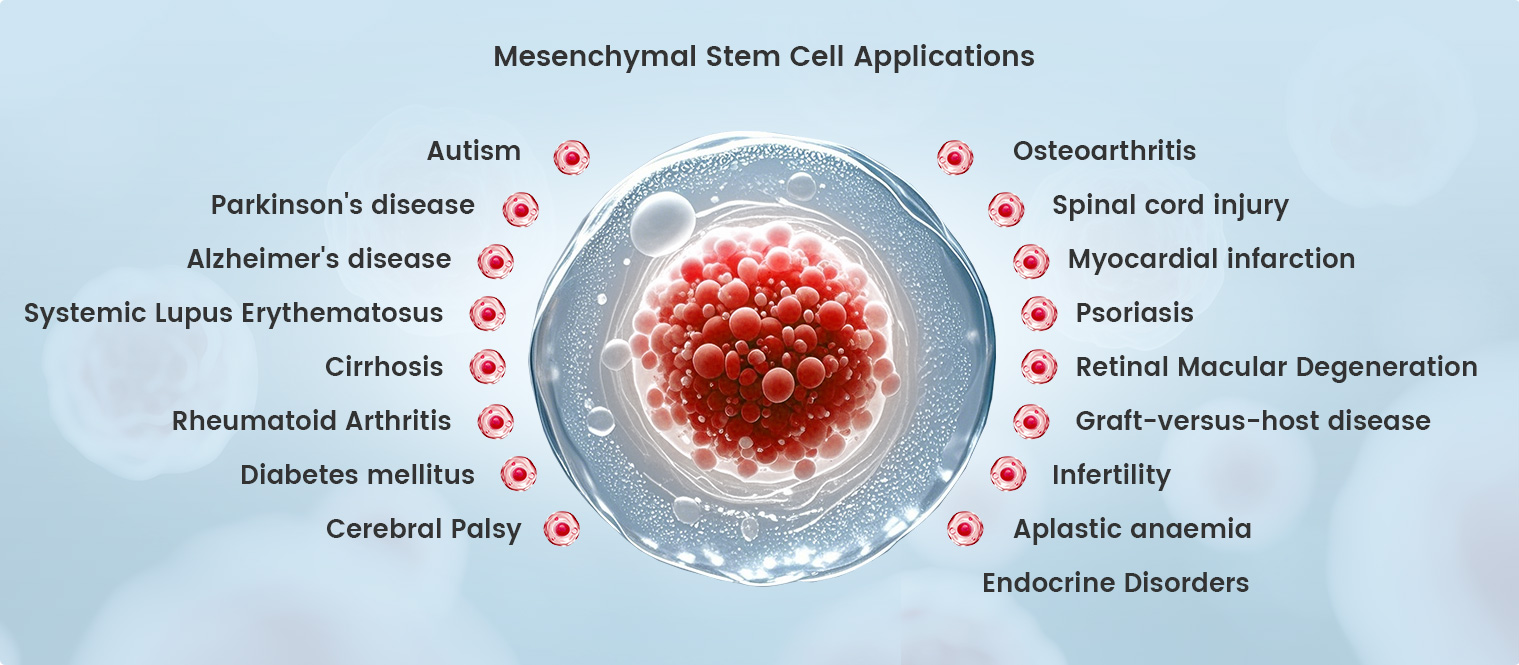Umbilical Cord Mesenchymal Stem Cells - Repair Masters
Mesenchymal stem cells are an important member of the stem cell family. Under specific induction conditions, they can differentiate into various specialized cells, including adipocytes, osteocytes, chondrocytes, myocytes, and tenocytes. Stem cells retain their multidirectional differentiation potential even after repeated subculturing and cryopreservation, making them excellent candidates for tissue and organ regeneration.
Clinical Research Scope:
Autoimmune diseases
● Rheumatoid arthritis, graft-versus-host disease, etc.
Cardiovascular and cerebrovascular diseases
● Myocardial infarction, cerebral infarction, etc.
Neurological diseases
● Spinal cord injury, Parkinson's disease, etc.
Endocrine disorders
● Type 1 diabetes, type 2 diabetes, and associated complications
Hematologic diseases
● Promotes hematopoietic function recovery and mitigates graft-versus-host disease, etc.
Degenerative diseases
● Osteoarthritis, Alzheimer's disease, etc.
Gastrointestinal diseases
● Liver cirrhosis, renal insufficiency, etc.
Orthopedic diseases
● Degenerative arthritis, femoral head necrosis, osteoporosis, bone nonunion, etc.
Gynecological diseases
● Premature ovarian insufficiency, intrauterine adhesion, etc.
Neonatal Stem Cell Types Available for Storage
Stem cell types | Placenta amniotic mesenchymal stem cells | Placenta subtotipotent stem cells | Umbilical cord mesenchymal stem cells | Perinatal hematopoietic stem cells Placenta blood hematopoietic stem cells |
Material source | Placenta | Umbilical cord | Perinatal and postpartum appendages | |
Direction of differentiation | Germ cells, neural stem cells, osteoblasts, and chondrocytes | Skin, nerves, lungs, liver tissue, adipocytes, hematopoietic cells, myocytes, and osteoblasts | Multiple tissue cells, including bone, cartilage, muscle, tendon, ligament, nerve, blood vessel, epithelium, and endothelium | Erythrocytes, leukocytes, immune cells, etc. |
Proliferative capability | Strong | Strong | Strong | Weak |
Usage | Multiple times | Multiple times | Multiple times | Provides multi-bag storage (1–2 times) |
Scope of application | Reproductive system diseases: Ovarian insufficiency, premature ovarian failure, prostatitis, and sexual dysfunction Neurological diseases: Spinal cord injury, Parkinson's disease
Degenerative diseases: Alzheimer's disease, cerebellar atrophy
Respiratory diseases: Acute lung injury/respiratory distress | Neurological diseases: Neural tube defects, hypoxic-ischemic encephalopathy, pediatric rare diseases, etc.
Cardiovascular and cerebrovascular diseases: Myocardial infarction, cerebral infarction, etc. | Metabolic diseases: Diabetes, gout, etc.
Immune system diseases: Rheumatoid arthritis, graft-versus-host disease
Bone tissue diseases: Osteoarthritis, cartilage injury, tendon injury, etc.
Gastrointestinal diseases: Liver cirrhosis, renal insufficiency, etc.
Combined transplantation with hematopoietic stem cells for the treatment of hematologic diseases | Hematologic diseases: Leukaemia, aplastic anemia, severe thalassemia, etc.
Malignant tumors: Lymphoma, etc. |
Other effects | Activating dormant cells, improving sub-health, and regulating physiological functions | |||
Matching requirements | No matching requirements, suitable for autologous use and family use, with better biocompatibility and enhanced efficacy. | For bone marrow transplantation, HLA matching is not required for autologous use, and the matching rate among family members can be as high as 25%–50%. For non-bone marrow stem cell sources, HLA matching is still not necessary. | ||
1999:
● Horwitz et al. used mesenchymal stem cells for the treatment of pediatric osteogenesis imperfecta and type I collagen deficiency in the USA
2003:
● Mazzini et al. used mesenchymal stem cells for the treatment of amyotrophic lateral sclerosis in Italy
● Fouillard et al. used mesenchymal stem cells for the treatment of aplastic anemia in France
2011:
● Treatment with mesenchymal stem cells significantly improved the activities of daily living in 229 patients with cerebral palsy in the Chinese PLA 463 Hospital
2015:
● A nerve regeneration collagen scaffold combined with mesenchymal stem cells for spinal cord injury has entered clinical research
2002:
● Koc et al. used mesenchymal stem cells for the treatment of mucopolysaccharidosis in the USA;
● Mesenchymal stem cells were used for the treatment of femoral head necrosis in the USA\
2005:
● Mesenchymal stem cells were used for the treatment of stroke in South Korea
● Rasulov et al. used mesenchymal stem cells for the treatment of skin burns in Russia
● Eighteen patients with aplastic anemia received mesenchymal stem cell therapy at the Twelfth People's Hospital of Guangzhou, with an overall effective rate of 72.2%
Uses of Umbilical Cord Mesenchymal Stem Cells:
Mesenchymal stem cells originate from the mesoderm during early development and are classified as pluripotent stem cells. Named for their presence in mesenchymal tissues, they exhibit multidirectional differentiation potential, support hematopoietic reconstruction, modulate immune responses, and possess self-renewal capacity. Under specific in vivo or in vitro induction conditions, mesenchymal stem cells can differentiate into various tissue-specific cell types, including osteoblasts, chondrocytes, myocytes, tenocytes, ligament cells, neurons, hepatocytes, cardiomyocytes, vascular cells, epithelial cells, endothelial cells, and adipocytes. Mesenchymal stem cells retain their multidirectional differentiation potential even after repeated subculturing and cryopreservation, making them ideal seed cells for repairing tissue and organ damage caused by aging or disease.
● Osteoarthritis
● Autism
● Spinal cord injury
● Cerebral palsy
● Myocardial infarction
● Diabetes
● Psoriasis
● Rheumatoid arthritis
● Retinal macular degeneration
● Liver cirrhosis
● Application scope of mesenchymal stem cells
● Graft-versus-host disease
● Alzheimer's disease
● Infertility
● Parkinson's disease
● Aplastic anemia
● Systemic lupus erythematosus
● Endocrine disorder








